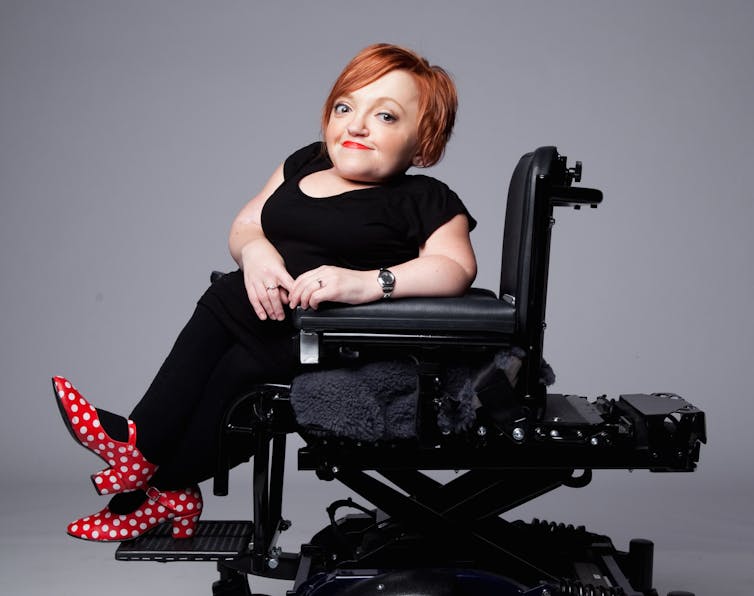
AAP Image/Supplied
Gerard Goggin, University of Sydney and Katie Ellis, Curtin University
We’ve made real progress in embracing disability as part of everyday life in Australia. But there’s a fair way to go, as the TEDx Sydney missed opportunity showed last week.
With much fanfare, TEDx launched #stellaschallenge, to kickstart conversations and transform disability through campaigns and media.
It was – potentially – a great idea, one that honoured the memory of celebrated comedian, journalist, and media figure Stella Young who died last year. TEDx was uniquely placed, because it had hosted Stella’s 2014 slam-dunk critique of disability as “inspiration porn” – a widely shared and talked about piece of media.
As details of #stellaschallenge emerged, it was obvious something had gone badly wrong.
At the heart of TEDx’s campaign to change attitudes was the recording of conversations with people with disabilities, especially, to ask them about their experience of disability. As framed by TEDx, it was patronising and simplistic, and really went against the grain of Stella’s own views. As Stella said in a 2013 interview with Star Weekly:
I understand that my presence makes people feel uncomfortable and that they have to say something to engage with me, but it’s very frustrating to have people comment on your presence everywhere you go.
Within hours, a social-media storm raged, with critique, satire, and outrage spreading internationally.
Two days later, TEDx announced that it would “re-set Stella’s challenge to be a project that represents all of our hopes and expectations”.
So maybe TEDx has a point, in suggesting:
even if it wasn’t in the way we had intended, the debate, engagement and activism in and around disability that followed the launch of Stella’s Challenge at TEDxSydney 2015 is a critical conversation to have.
Well, yes, and no.
Full credit to TEDx for its quick response and signalling a change of tack. And, if it follows through, for being prepared to engage with the disability community over the long term. But what’s the way forward – not just for TEDx, but for Australian media and culture generally?
The TED effect
TED is a fascinating kind of new media platform, revolving around its catchy format of compelling, slick, widely broadcast and downloaded talks. Backing the “power of ideas to change attitudes, lives, and ultimately, the world”, its brand has caught on, in its satellite events run by its partners internationally.
Courtesy of the internet, TED has made a real contribution in bringing the live talk back into contention. Its strong suit is an immediately recognisable platform for a certain kind of performance – and circulation of ideas.
However, unlike other traditional media organisations – and some new ones too – TED lacks experience with how to program, curate, develop, and represent sensitive and contentious cultural issues.
It also lacks a deep understanding of disability – especially, the paramount importance of people with disabilities shaping and directing the things that affect their lives. Yet, as Jax Jacki Brown points out, with TEDx’s reach and funding, “it could be an opportunity to really address disability disadvantage”.
This is especially so because, in the media, there are surprisingly few resources for creative, clever, and sustained work that offers the diverse stories, images, analysis, narratives, and representations we need. This kind of vision of a vibrant, disability rich public media is important, because the ways it helps us reimagine our society – and tackle disability injustice.
The stories we need
So, strangely enough, given the great promise and many channels of the contemporary media environment, we have a long way to go in telling stories about disability.
What does exist is underresourced, or, if resourced for a while, funds are cut. Take the pioneering ABC disability blog, RampUp, edited by Stella Young herself. It was funded on the smell of an oily rag, and even that was axed by the ABC in mid-2014. Much as the RampUp closure was deplored by Stella herself, and the subject of a campaign for its reinstatement, nothing has happened.
Then there are the many vibrant projects undertaken by people with disabilities, supporters and allies, and organisations across the arts and cultural sector in particular – but also in media, such as the Melbourne-based No Limits community television program, where Stella got her start in the media.
Key to the disappointment and anger felt by many in response to #stellaschallenge is a palpable irony. TEDx Sydney calls for conversations – but doesn’t recognise that there are already many conversations, relationships, and media, attitudinal, and social transformations underway. So, rather than speaking, genuine listening is required – often the hardest thing to do.
Fabulous as Stella’s TEDx talk is, it’s time to go beyond just resharing it. We need to really listen to it. We must acknowledge and support the many other voices of people with disabilities.
TEDx Sydney should refocus its #Stellachallenge to offer media access, resources, and sorely needed distribution, so these voices can flourish, and be widely heard.![]()
Gerard Goggin, Professor of Media and Communications , University of Sydney and Katie Ellis, Senior Research Fellow in Internet studies, Curtin University
This article is republished from The Conversation under a Creative Commons license. Read the original article.